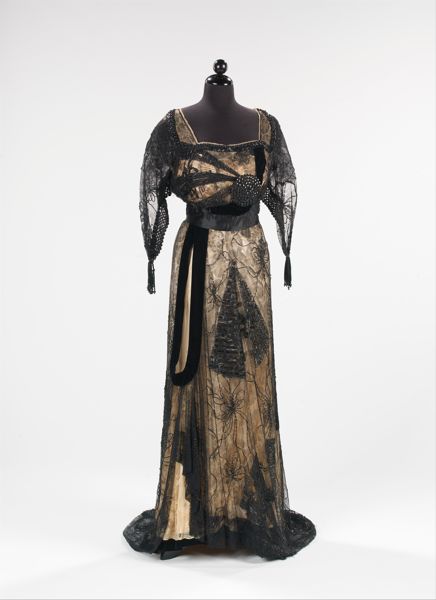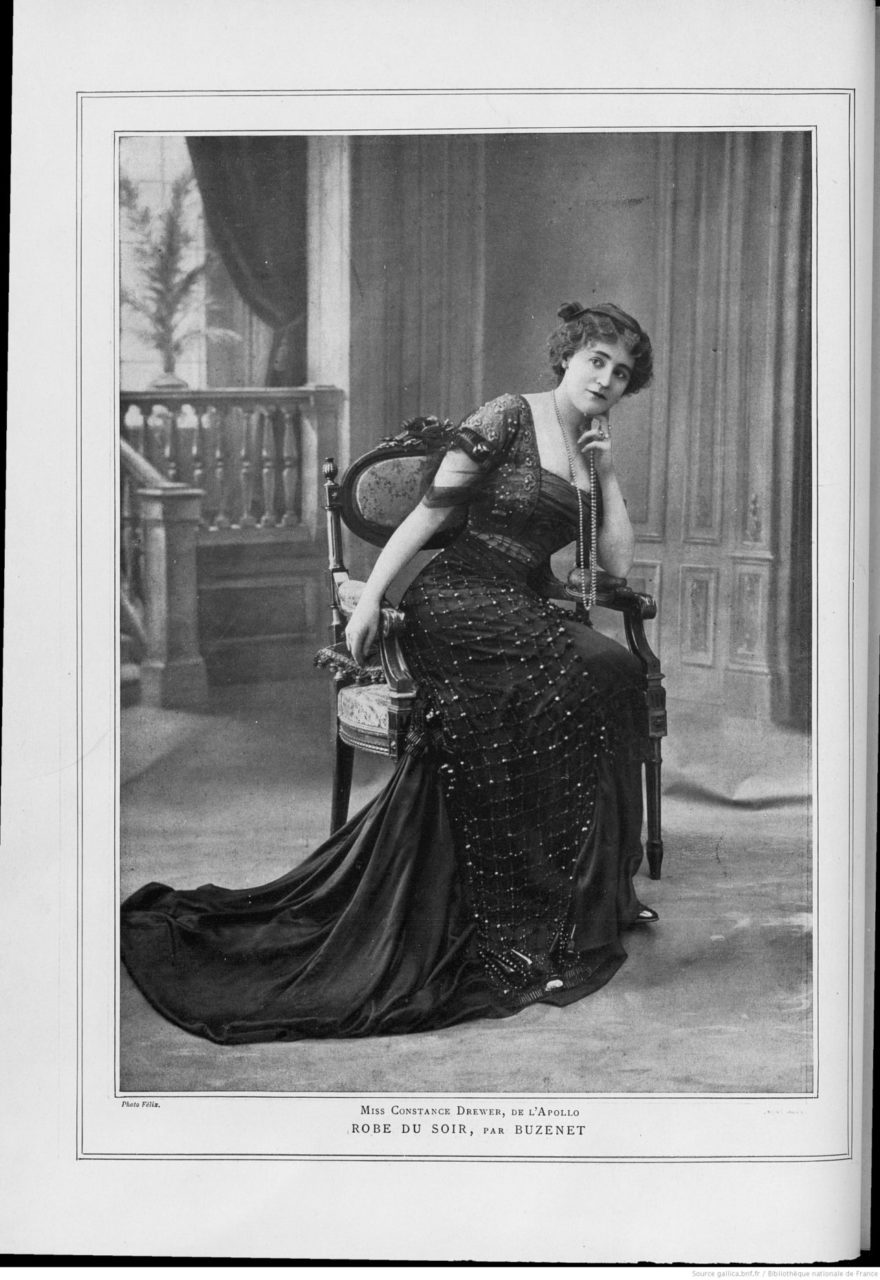This Callot Soeurs evening dress, influenced by Orientalism and the Directoire revival, embodies the latest trends of the time in its cylindrical silhouette and soft, unstructured look.
About the look
This columnar evening dress has two parts: a thin underdress of beige cotton acts as an opaque slip layer under a transparent net overlay embroidered with gold, silver, pink, and copper sequins. This intricate over-layer of ornamentation was a bold style marker of the Callot Soeurs couture house, with a variety of complicated techniques and patterns applied for this type of adornment. Regarding the dress’ elaborate use of sequins, The Metropolitan Museum of Art notes that:
“Some are punched into a filigree pinwheel, others are hammered flat; in some instances metal is overlaid onto faceted crystal. But even this ornamentation is not entirely for the pleasure of diversity, but for the calculated and magical effects of such varied surfaces seen in evening and candle lights.”
Some of the intricacy of this embellishment is shown in figure 1. The weight of the sequins and applied stones add pressure to thin net, causing the upper layer to fall closer to the body. The design of the sequins was inspired by Japanese ukiyo-e (浮世絵, “pictures of the floating world”) prints. The evening dress also has a faint monobosom silhouette (the vestiges of a style popular in the previous decade) and a raised waistline, which historians Daniel James Cole and Nancy Deihl attribute to an influence from the Directoire style of a century earlier. Often seen in soft mousseline dresses, this trend was described with terms such as “Mme Recamier style,” (Fig. 2) “Josephine frock,” (referring to Empress Joséphine, wife of Napoleon) and “Empire gown” (Cole 108). In other words, the narrow, cylindrical silhouette that followed the figure of the body was popular in that period, and was revived anew in the Edwardian era. The raised waistline was emphasized with a band of sequins and the very deep scoop neck.
Fig. 1 - Callot Soeurs (French, 1895–1937). Evening dress, 1910-14. Cotton, silk, metal. New York: The Metropolitan Museum of Art, 1981.380.2. Gift of Jacqueline Loewe Fowler, 1981. Source: The Metropolitan Museum of Art
Fig. 2 - François Gérard (French, 1770 - 1837). Portrait de Juliette Récamier, ca. 1805. Oil on canvas; height: 225 cm, length: 148 cm. Paris: Musée Carnavalet, P 1581. Source: Musée Carnavalet
Callot Soeurs (French, active 1895-1937). Evening dress, 1910-14.cotton, silk, metal. New York: The Metropolitan Museum of Art, 1981.380.2. Gift of Jacqueline Loewe Fowler, 1981. Source: The Metropolitan Museum of Art
About the context
The Metropolitan Museum of Art first introduces this evening dress after identifing its sumptuousness and short sleeves, which would be met on the arm by long kid leather gloves, by discussing its inspirations:
“In the Directoire revival, the waistline was raised in the manner of a century earlier, but with corsetting that had the vestiges of the monobosom. Perhaps even more importantly, the silhouette reflects Europe’s examination of Eastern dress, the softness, raised waist, and lower bust stance suggesting ‘ukiyo-e’ prints and other Japanese style.”
The Directoire influence came into fashion with high-waisted bodices, close-fitting drapery, and subtle folds, which reflected the styles of exactly a century before. A fashion plate from La Moda Elegante Ilustrada (1910) depicts the Directoire revival style, otherwise called the “Empire gown” (Fig. 3). Most importantly, the Eastern influence was signaled with the help of ‘Oriental’ art and décor. Motifs from Asia are clearly depicted in the illustraion in figure 4, which goes even further in suggesting Indian influence with the sheer odhni- or ghoonghat-like scarf draped over the model’s hair. Cole explains the rise of Orientalism in the 1910s:
“The decade’s taste for Orientalism encompassed a wide range of influences including Turkish, North African, Egyptian, Persian, and Far Eastern. Fashion magazines were filled with features on Eastern themes, and exotic locales provided settings for fashion illustrations. Draped shawls, brocaded fabrics, beads, and fringes all contributed to a world of exotic fantasy.” (107)
This dress was designed accordingly, conforming to the common details of evening dresses in the 1910s. As Cole and Deihl further detail:
“At the beginning of the decade, the most important news was the narrowing and straightening of the silhouette, and simpler, straighter construction of garments. The waistline moved higher up the body. Bodices were less fitted through sides and back but lost their fullness in the front, eliminating the matronly blousing effect of the previous decade.” (107)
This empire-style, narrowed silhouette is evident in figures 5 and 6. The Met notes that the Callot sisters, who ran the Parisian couture house in which the dress was designed, were attuned to the Orientalist fads and excesses of the decade but restrained the silhouette into an effortless columnar look in lingerie-weight fabric – a Classical Greek-inspired twist on the Indian and Japanese elements popular with other couturiers. A similarly designed Callot Soeurs dress shown in figure 7 is again made with Asian-inspired textiles and trimmings in the form of lavish beadwork and draped sleeve details.
Fig. 3 - Artist unknown (Spanish). Fashion plate from La Moda Elegante Ilustrada, 1910. Lithograph. New York: FIT Special Collections, lb_sc_000246. Source: SPARC
Fig. 4 - Maison Marianne Buzenet (French, active c.1908-1916). Les Modes: revue mensuelle illustrée des Arts décoratifs appliqués à la femme: "Robe Du Soir, Par Buzenet", Vol. 10, no. 110 (Feb 1910). Paris: Bibliothèque nationale de France, Fol-v-4312. Photo Boissonnas & Taponier. Source: Bibliothèque nationale de France
Fig. 5 - Maison Weeks (French, active c. 1910-18). Evening dress, 1911. Silk, metal, glass. New York: The Metropolitan Museum of Art, C.I.57.17.3. Gift of Mrs. C. Phillip Miller, 1957. Source: The Metropolitan Museum of Art
Fig. 6 - Ethel Rose (Illustrator) (Probably American). New Evening Gowns, Vol. 45, Iss. 12 (Dec 1911). New York: The Harper's Bazaar Archive, 1832529709. Source: ProQuest
Fig. 7 - Callot Soeurs (French, 1895–1937). Evening dress, 1913. Silk, jet beads. New York: The Metropolitan Museum of Art, 2009.300.1194. Gift of the Brooklyn Museum, 2009. Source: The Metropolitan Museum of Art
Valerie D. Mendes in Fashion Since 1900 (2010) describes the period from 1900 to 1914, or “La Belle Epoque,” as a time in which elegantly attired men and women of power, elevated in social rank, engaged in leisurely pastimes. Haute couture was raised to a new level by Parisian design houses like Maison Paul Poiret and Callot Soeurs, while the much earlier established House of Worth was in its second generation of leadership and declining in importance (Fig. 8). Of the Parisian couturiers – Callot Soeurs, Doucet, Paquin, and Worth, who constantly strove for the new, Cole and Deihl note that Callot Soeurs in particular achieved greatness:
“The creations of Callot Soeurs were considered among the finest available. Under the direction of Marie Callot Gerber, the house experimented with sleek, streamlined modern looks and continued their use of fine fabrics utilizing laces, lamé, and brocades embellished with exquisite detail to create a sense of overt elegance and luxury. Orientalism continued to be a recurrent theme, and they showed avant-garde pajama ensembles as early as 1911.” (121)
The reactions to this evening dress and others were favorable, according to fashion magazines such as Harper’s Bazar (sic). Their special September 1911 issue on French evening gowns points out the popular low-cut neckline style of the decade (Fig. 9):
“The low-cut gown for the evening has so much to recommend it and is so economical that it should be included in the simplest outfit. There is no better investment than a gown simply made, with plain skirt and little train and a waist cut round, V-shaped, or collarless, and with elbow sleeves. This can be made of silk-finish cashmere, satin, or silk: the two first named wear longest and this sort of dinner dress does not go out of fashion. It can always be renovated and brought up to date by the trimming on the waist.” (407)
This periodical emphasizes that this decade made good advantage of odd pieces of material and relied upon handsome trimmings to update fashions, including pieces of embroidered or spangled lace and passementerie. The details in figure 10 show how these embellishments were often placed across the bust, waist, or a panel down the front, much like the Callot Soeurs evening dress.
Fig. 8 - Jean-Philippe Worth (French, 1856–1926). Evening dress, 1910. Silk, metal. New York: The Metropolitan Museum of Art, 2009.300.3355. Gift of the Brooklyn Museum, 2009. Source: The Metropolitan Museum of Art
Fig. 9 - Unknown. Les Modes: revue mensuelle illustrée des Arts décoratifs appliqués à la femme: Mme René Nagelmackers, Née Dalziel, Vol. 10, no. 109 (Jan 1910). Paris: Bibliothèque nationale de France, Fol-v-4312. The Dover Street Studios (London). Source: Bibliothèque nationale de France
Fig. 10 - Jeanne Hallée (French, 1880–1914). Evening dress, 1910–14. Silk, glass. New York: The Metropolitan Museum of Art, 1981.328.5. Isabel Shults Fund, 1981. Source: The Metropolitan Museum of Art
Fig. 11 - Maison Marianne Buzenet (French, active c. 1908-1916). Les Modes: revue mensuelle illustrée des Arts décoratifs appliqués à la femme: Miss Constance Drewer, De L'Apollo Robe Du Soir, Par Buzenet, Vol. 10, no. 109 (Jan 1910). Paris: Bibliothèque nationale de France, fol-v-4312. Photo by Félix. Source: Bibliothèque nationale de France
The Callot Soeurs gown may be considered as the epitome of elegance and good taste in this period. Lace tunics enhanced with shimmering embellishments, often worn over an opaque bottom dress layer, were widely accepted by other designer houses and consumers. The tunic-style overlay, often in lace or net, is apparent in a photograph of Constance Drewer in a robe du soir (evening dress) from 1910 (Fig. 11). In The History of Twentieth Century Fashion, Elizabeth Ewing points out that this evolved into the robe de style fashion popular in the 1920s:
“To satisfy the still powerful class-consciousness that invested clothes, new variations came into top fashion, with Poiret in the lead…By 1912 floating panels and panniers were also appearing on skirts to vary the line and this led to a fashion for wide tunics, worn over tube-like skirts. For evening-wear these tunics were made of lace and other filmy materials, often embroidered with silver or gold.” (69)
Evening wear like the Callot Soeurs dress was in-demand for trendy women and gained acceptance in the fast-moving world of fashion.
Its Afterlife
T
o this day, the empire silhouette has continued to be an important trend in fashion. A high waist paired with a long, straight skirt is seen in Shiatzy Chen’s Fall 2017 ready-to-wear ensemble (Fig. 12). The Fall 2016 couture collections especially, in which the Fendi dress in figure 13 was showcased, showed the Empire silhouette to be on the rise.
Orientalism is an extremely problematic concept today in an industry rife with cultural appropriation, but continues to loom large in fashion. Take, for example, Gucci’s Fall 2016 ready-to-wear dress with intricate Asian-inspired motifs and embellishments, not to mention the cheongsam-style cut (Fig. 14). In fashions like these, we see the same type of influence present a century ago in the Orientalist work of Callot Soeurs.
Fig. 12 - Wang Chen Tsai-Hsia (Taiwanese, 1951-). Shiatzy Chen RTW dress, Fall 2017. Source: Women's Wear Daily
Fig. 13 - Karl Lagerfeld (German, 1933-2019). Fendi Couture dress, Fall 2016. Photo by Monica Feudi. Source: Vogue
Fig. 14 - Alessandro Michele (Italian, 1972-). Gucci RTW dress, Fall 2016. Photo by Yannis Vlamos. Source: Vogue
References:
- “Callot Soeurs | Evening Dress | French | The Met.” The Metropolitan Museum of Art. Accessed February 17, 2019. https://www.metmuseum.org/art/collection/search/81139.
- Cole, Daniel James, and Nancy Deihl. The History of Modern Fashion From 1850. London: Laurence King Publishing, 2015. http://www.worldcat.org/oclc/932219920.
- Ewing, Elizabeth. The History of 20th Century Fashion. New York: Scribner, 1974. http://www.worldcat.org/oclc/901222900.
- “French Evening Gowns.” Harper’s Bazaar 45, no. 9 (September 1911): 407. https://libproxy.fitsuny.edu:2818/docview/1832518969?accountid=27253.
- Mendes, Valerie D., and Amy De La Haye. Fashion Since 1900. 2nd ed. London; New York: Thames & Hudson, 2010. http://www.worldcat.org/oclc/757654608.

























